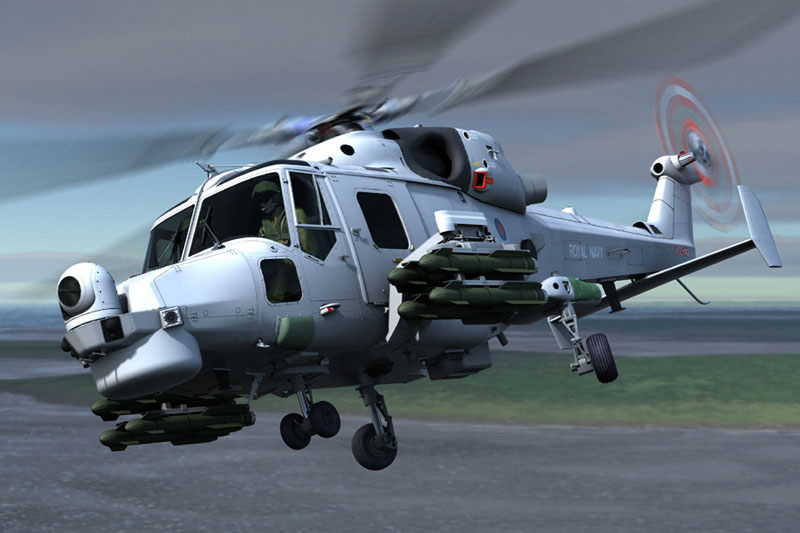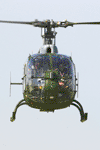
Background latest update 12 July 2005

The Future Lynx was
born out of different requirements from the Army Air Corp and the Fleet Air Arm.
The AAC required a utility and light transport helicopter to replace the Lynx
fleet, as well as light reconnaissance helicopter to replace Gazelles. The FAA
required a replacement to the ship borne Lynx anti surface helicopter.
Corp and the Fleet Air Arm.
The AAC required a utility and light transport helicopter to replace the Lynx
fleet, as well as light reconnaissance helicopter to replace Gazelles. The FAA
required a replacement to the ship borne Lynx anti surface helicopter.
Lynx
performance in moderate European climates was sufficient, however it had a
relatively small cabin so was not completely suited to the hot and high  troop
transport roles that the Army was increasingly being called upon to perform.
Lynx first came into service in the late 1970's so were showing their age.
Many Gazelles were even older and were already being phased out. The BLUH
program to replace AAC Lynx would ideally have provided a much larger cabin,
capable of easily taking 8 or 9 troops with their kit, as well as improved hot
and high performance, integrated avionics and better reliability. The BRH
requirement was for a smaller, light and agile helicopter to integrate with and
designate for the Apache attack helicopters. The Royal Navy
troop
transport roles that the Army was increasingly being called upon to perform.
Lynx first came into service in the late 1970's so were showing their age.
Many Gazelles were even older and were already being phased out. The BLUH
program to replace AAC Lynx would ideally have provided a much larger cabin,
capable of easily taking 8 or 9 troops with their kit, as well as improved hot
and high performance, integrated avionics and better reliability. The BRH
requirement was for a smaller, light and agile helicopter to integrate with and
designate for the Apache attack helicopters. The Royal Navy  SCMR requirement was
for a small, agile, anti-surface warfare helicopter with improved sensors and
the ability to carry current and future torpedoes and missiles.
SCMR requirement was
for a small, agile, anti-surface warfare helicopter with improved sensors and
the ability to carry current and future torpedoes and missiles.
And so enter the MoD accountants. A brilliant plan was hatched which amazingly managed to combine all three disparate requirements into a single aircraft type, and at the same time provide a long term multi-million pound contract to the UKs only helicopter manufacturer.
 Future Lynx is
exactly what the Fleet Air Arm need to replace their old Lynxes. Speaking in
2002, the defence procurement minister Lord Bach stated that "These
aircraft will need replacement in the next six years", so we should be
seeing these in about 2008 by that reckoning! As to the AAC requirements, well
BRH seems to have been quietly shelved, and the BLUH specification has been
"tweaked" to be more in line with what Future Lynx can deliver. The
cabin size issue will be ignored, and if anything made worse as crash-worthy
seating will have an impact on available space. BLUH
will have a good array of avionics and sensors to allow some integration with
Apache, but with only 34 airframes on order, it cannot be in every place at
once. The vastly improved engine performance too will be a great benefit, and
the fitting of wire-strike protection will be welcomed (this should be standard
on all military helicopters).
Future Lynx is
exactly what the Fleet Air Arm need to replace their old Lynxes. Speaking in
2002, the defence procurement minister Lord Bach stated that "These
aircraft will need replacement in the next six years", so we should be
seeing these in about 2008 by that reckoning! As to the AAC requirements, well
BRH seems to have been quietly shelved, and the BLUH specification has been
"tweaked" to be more in line with what Future Lynx can deliver. The
cabin size issue will be ignored, and if anything made worse as crash-worthy
seating will have an impact on available space. BLUH
will have a good array of avionics and sensors to allow some integration with
Apache, but with only 34 airframes on order, it cannot be in every place at
once. The vastly improved engine performance too will be a great benefit, and
the fitting of wire-strike protection will be welcomed (this should be standard
on all military helicopters).
The 34 (down from 40) AAC aircraft are due in servce from 2014, with another 28 (down from 30) being procured for the FAA due in service from 2015. There are also options for 10 more (5 for each service). The aircraft has a fully marinised airframe with a wheeled tricycle undercarriage. Powered by two CTS800 engine giving about a third more power than the old Gems, the aircraft should have an endurance of up to 3 hours.
Major Future Lynx Milestones are detailed
here.
Please note that the author of this website has no connection or affiliation with Westlands, the Fleet Air Arm, or the Army Air Corps. Also be aware that the organisations mentioned have not condoned, authorised or in any way assisted with this site. This is purely a personal project which has taken on a bit of a life of it's own, and thanks must go to all the individuals who have contributed to it in any way. If you feel you have something to add, or notice something obviously wrong, then please let me know by using the feedback form available on the left frame.